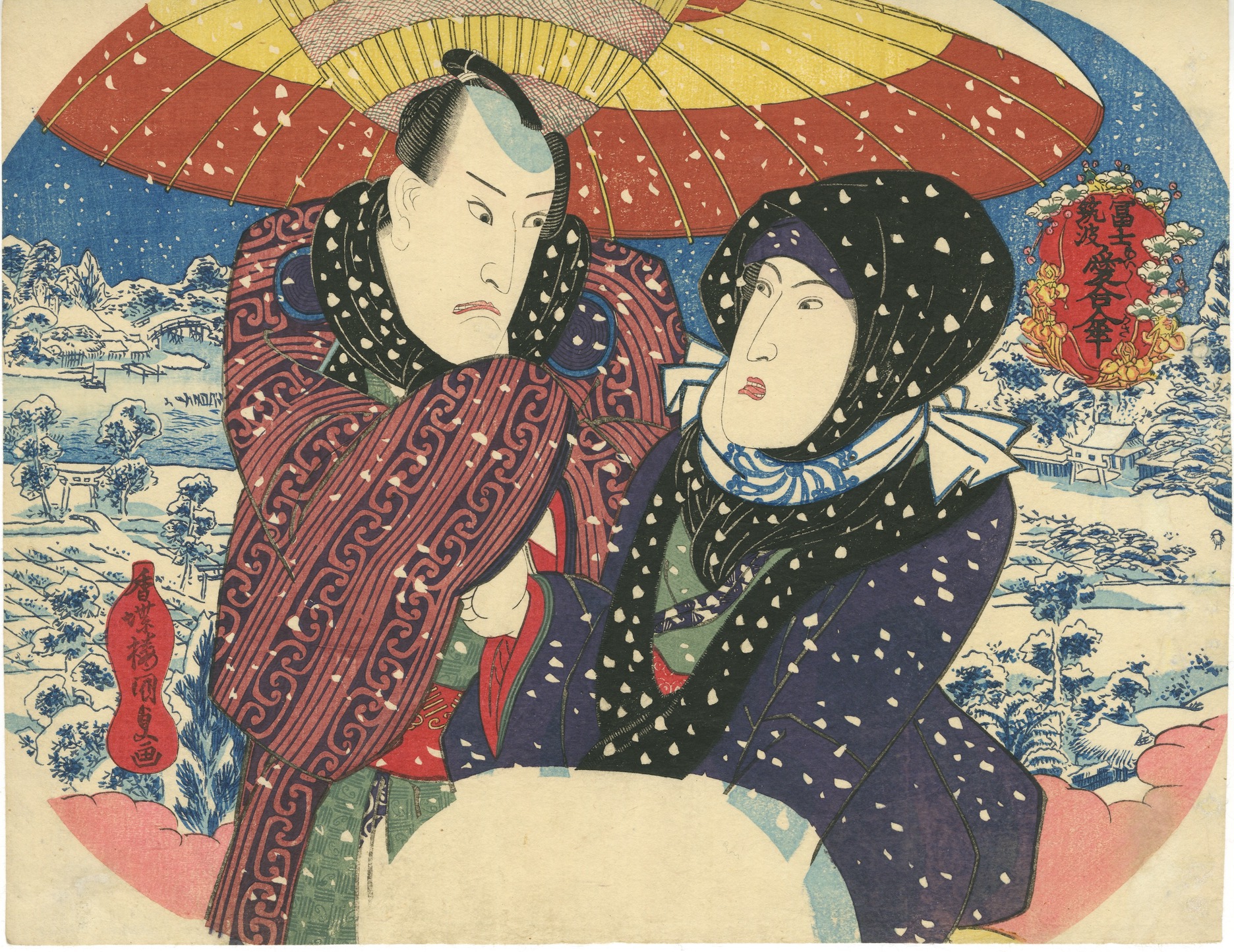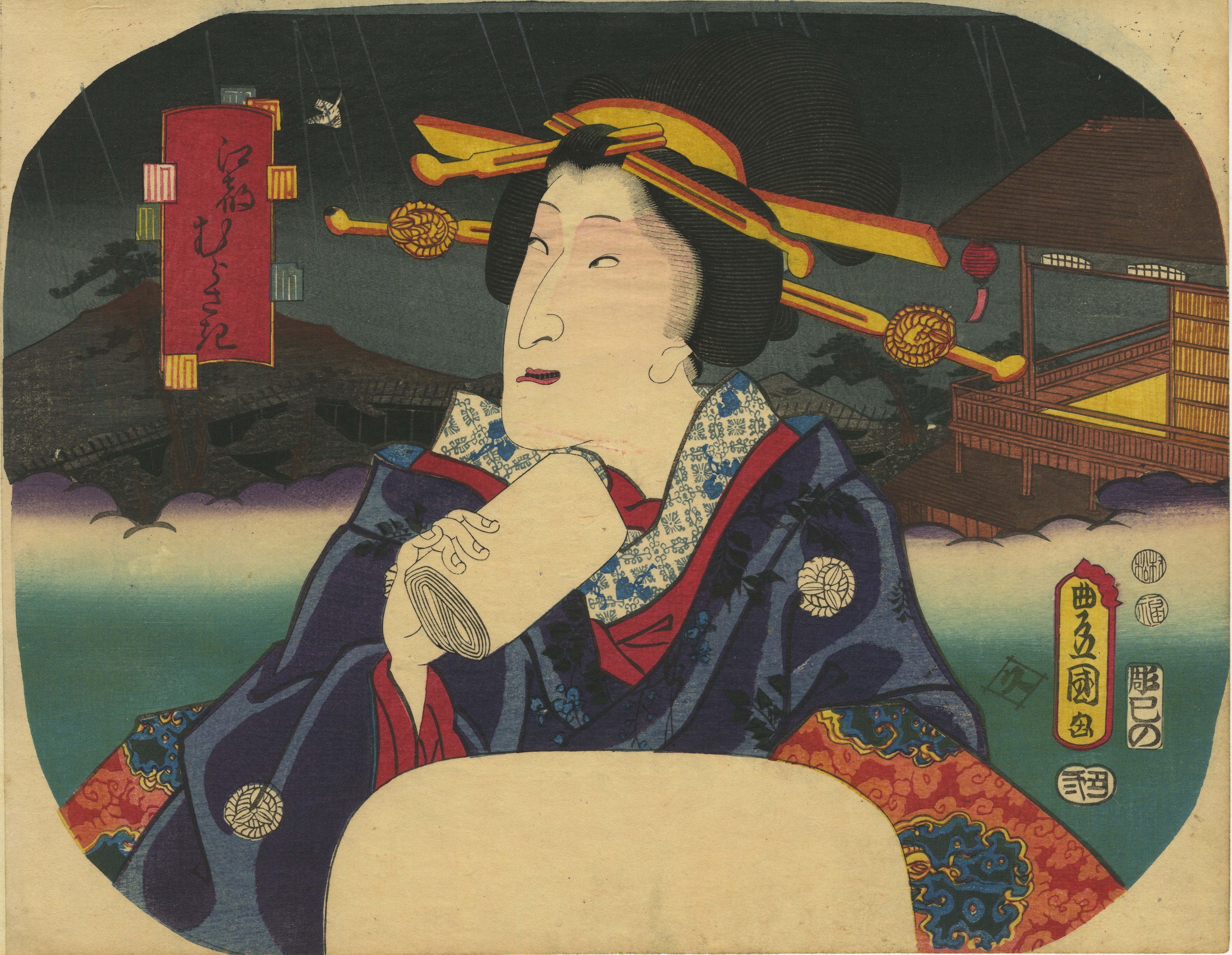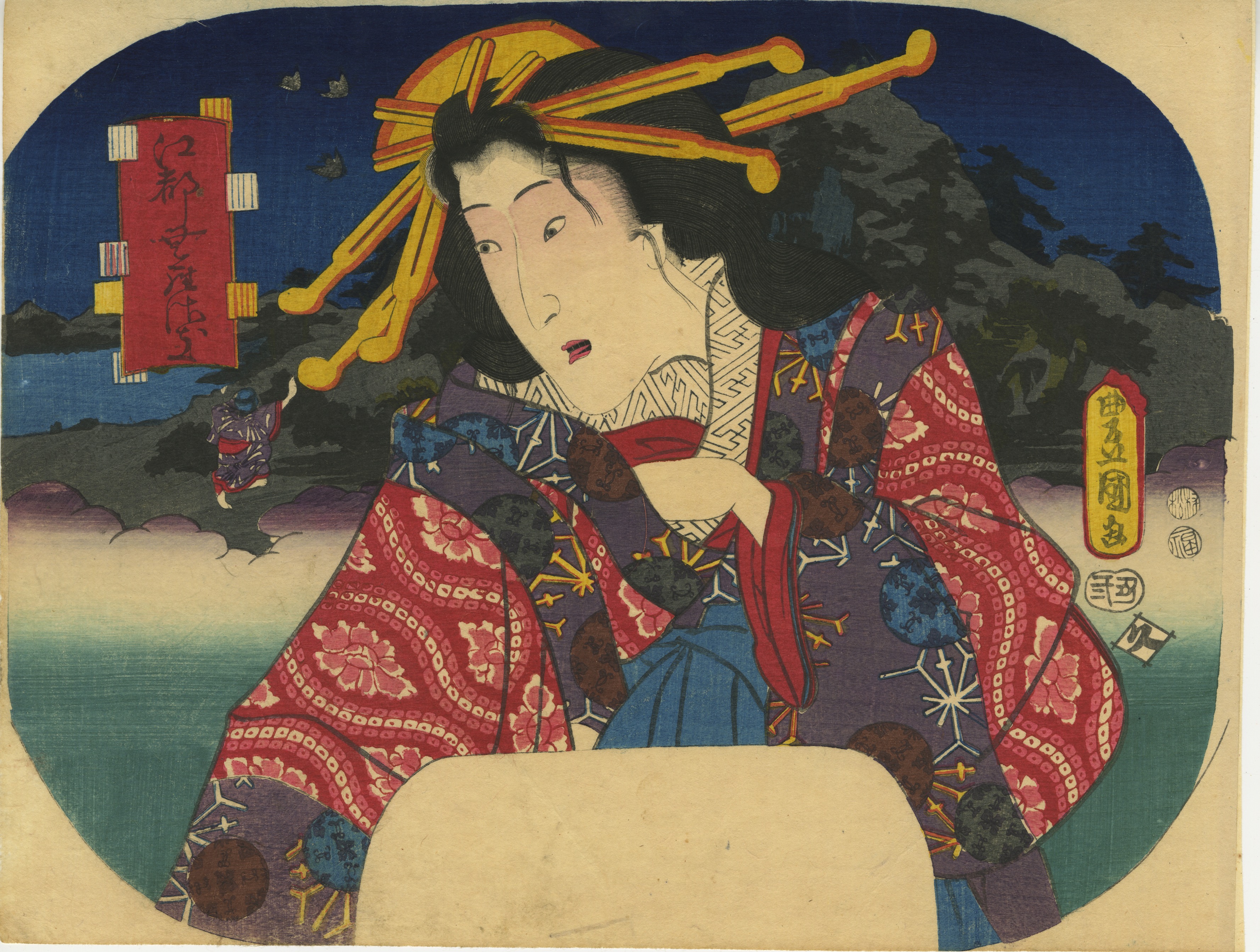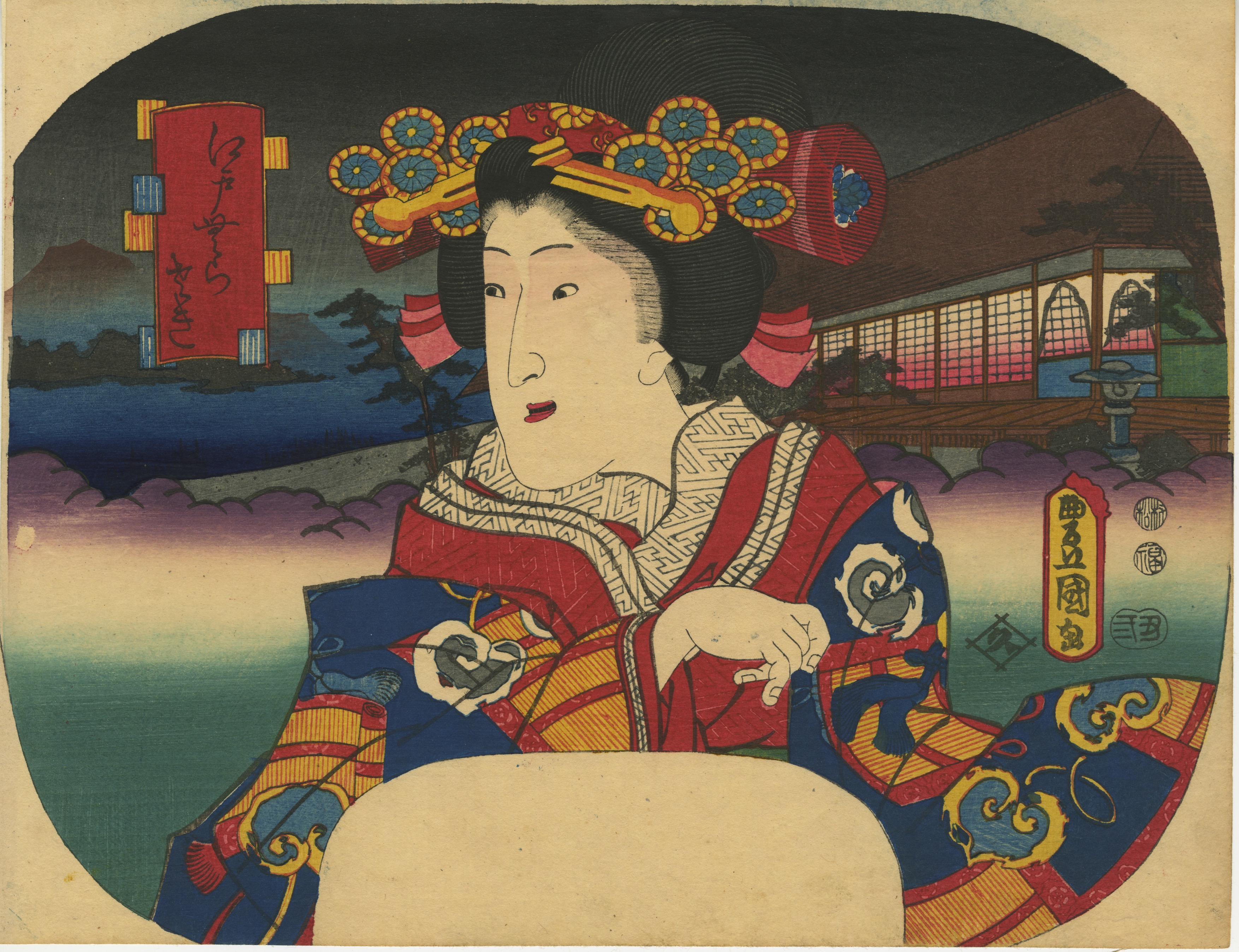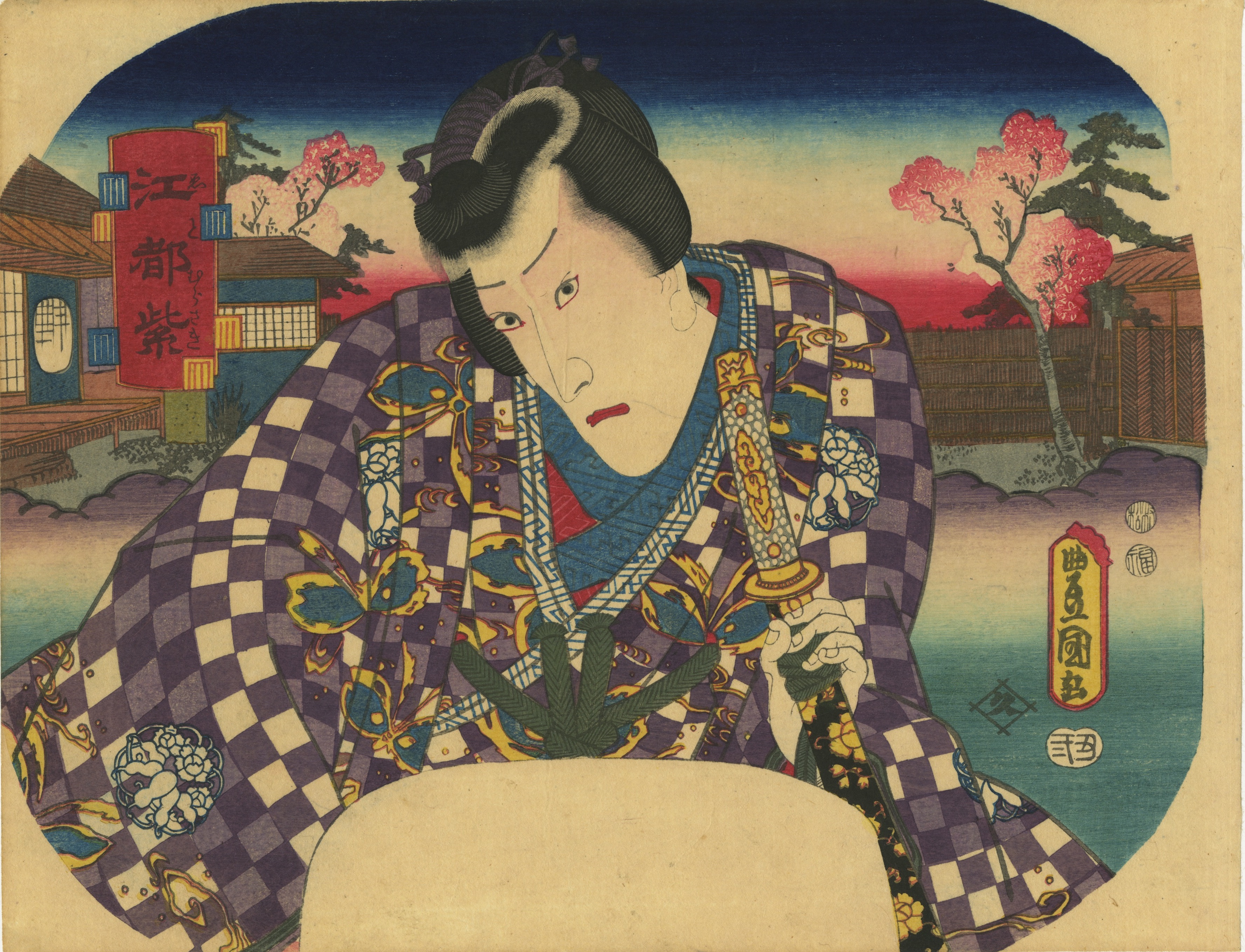-
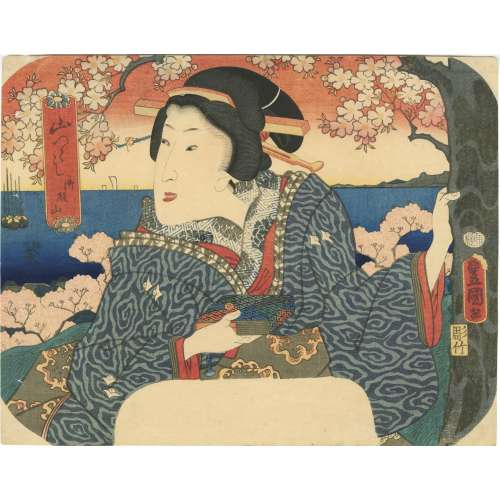 Title: Gotenyama [御殿山] – one of the most popular cherry blossom viewing spots; it is a hill at Shinagawa [品川], the second station on the Tōkaidō road [東海道], located on the shores of Edo Bay [江戸湾]. Series: A Collection of Mountains [山つくし] (Yama tsukushi) Artist: Utagawa Kunisada [歌川 国貞] a.k.a. Utagawa Toyokuni III [三代歌川豊国] (Japanese, 1786 – 12 January 1865). Block carver: Yokokawa Takejirō, seal: [彫竹] – Hori Take. Publisher: Yama-Ta; seal: [板元, 太] – Hanmoto, Ta; Marks 19-044 | U421b: An unknown publisher in Edo, fl. c. 1815-61. Combined date seal and kiwame censor seal: Ansei 6 (1851). Signed: Toyokuni ga [豊国 画] in a red toshidama cartouche. Size: Fan print (uchiwa-e) 227 x 287 mm.
Title: Gotenyama [御殿山] – one of the most popular cherry blossom viewing spots; it is a hill at Shinagawa [品川], the second station on the Tōkaidō road [東海道], located on the shores of Edo Bay [江戸湾]. Series: A Collection of Mountains [山つくし] (Yama tsukushi) Artist: Utagawa Kunisada [歌川 国貞] a.k.a. Utagawa Toyokuni III [三代歌川豊国] (Japanese, 1786 – 12 January 1865). Block carver: Yokokawa Takejirō, seal: [彫竹] – Hori Take. Publisher: Yama-Ta; seal: [板元, 太] – Hanmoto, Ta; Marks 19-044 | U421b: An unknown publisher in Edo, fl. c. 1815-61. Combined date seal and kiwame censor seal: Ansei 6 (1851). Signed: Toyokuni ga [豊国 画] in a red toshidama cartouche. Size: Fan print (uchiwa-e) 227 x 287 mm. -
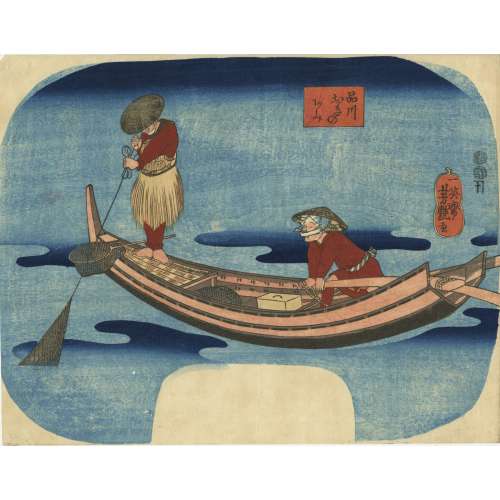 Artist: Utagawa Yoshitsuya [歌川 芳艶] (Japanese, 1822 – 1866). Publisher: Kojimaya Jūbei [小島屋重兵衛] (Japanese, c. 1797 – 1869). Date seal and double nanushi censor seals: Kunigasa & Yoshimura, Kōka 5 (1849). Signed: Ichieisai Yoshitsuya ga [英斎芳艶画] in a red double gourd cartouche. Two men are fishing with a net off the coast of Shinagawa, in the Edo Bay.
Artist: Utagawa Yoshitsuya [歌川 芳艶] (Japanese, 1822 – 1866). Publisher: Kojimaya Jūbei [小島屋重兵衛] (Japanese, c. 1797 – 1869). Date seal and double nanushi censor seals: Kunigasa & Yoshimura, Kōka 5 (1849). Signed: Ichieisai Yoshitsuya ga [英斎芳艶画] in a red double gourd cartouche. Two men are fishing with a net off the coast of Shinagawa, in the Edo Bay. -
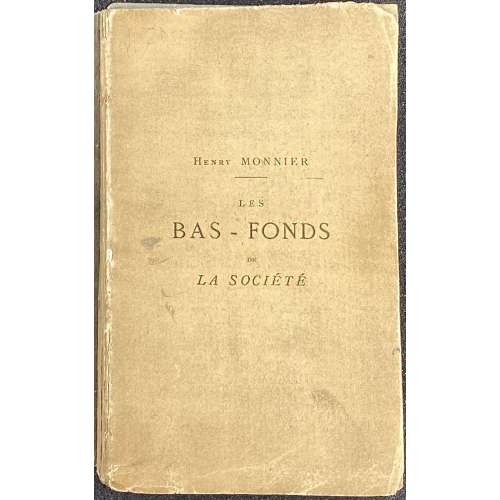 Small softcover volume, ‘édition minuscule’ in-32, 13 x 8 cm, publisher’s wrappers, pp.: [1-6] (h.t., t.p., advert.), [7] 8-160 [2 table/blank], included in pagination 8 pasted etchings on India paper after Félicien Rops and one blank leaf next to plate 1; laid paper with watermarks, some pages uncut. Title-page: DOCUMENTS | POUR SERVIR A L’HISTOIRE DE NOS MŒURS | – | LES | BAS-FONDS | DE LA SOCIÉTÉ | PAR | HENRY MONNIER | AVEC | 8 dessins à la plume | de F. R. | {fleuron} | ÉDITION MINUSCULE | tirée | à 64 exemplaires. || Pencil handwriting on top: 8 gravures de Felicien Rops | 250 –, in the bottom: [1879]. Print run: 64 copies; clandestine edition. Catalogue raisonné: Vicaire V, 1019; Bory p. 100 (though here is the frontispiece for Les Bas-fonds de la société par Joseph Prudhomme [Henry Monnier], 1864, with all the sheets together; Dutel I, A-134. Ref: (1) Poulet-Malassis & ses amis № 90 [LIB-3118.2022] ; (2) Félicien Rops: L'oeuvre graphique complète. / Ouvrage établi et présenté par Jean-François Bory. Avec un texte contemporain de l'artiste par J. K. Huysmans. — Arthur Hubschmidt, 1977. [LIB-2241.2019] Contributors: Henry Monnier (French, 1799 – 1877) – author. Félicien Rops (Belgian, 1833 – 1898) – artist. Henry Kistemaeckers (Belgian, 1851 – 1934) – publisher. Auguste Poulet-Malassis (French, 1825 – 1878)
Small softcover volume, ‘édition minuscule’ in-32, 13 x 8 cm, publisher’s wrappers, pp.: [1-6] (h.t., t.p., advert.), [7] 8-160 [2 table/blank], included in pagination 8 pasted etchings on India paper after Félicien Rops and one blank leaf next to plate 1; laid paper with watermarks, some pages uncut. Title-page: DOCUMENTS | POUR SERVIR A L’HISTOIRE DE NOS MŒURS | – | LES | BAS-FONDS | DE LA SOCIÉTÉ | PAR | HENRY MONNIER | AVEC | 8 dessins à la plume | de F. R. | {fleuron} | ÉDITION MINUSCULE | tirée | à 64 exemplaires. || Pencil handwriting on top: 8 gravures de Felicien Rops | 250 –, in the bottom: [1879]. Print run: 64 copies; clandestine edition. Catalogue raisonné: Vicaire V, 1019; Bory p. 100 (though here is the frontispiece for Les Bas-fonds de la société par Joseph Prudhomme [Henry Monnier], 1864, with all the sheets together; Dutel I, A-134. Ref: (1) Poulet-Malassis & ses amis № 90 [LIB-3118.2022] ; (2) Félicien Rops: L'oeuvre graphique complète. / Ouvrage établi et présenté par Jean-François Bory. Avec un texte contemporain de l'artiste par J. K. Huysmans. — Arthur Hubschmidt, 1977. [LIB-2241.2019] Contributors: Henry Monnier (French, 1799 – 1877) – author. Félicien Rops (Belgian, 1833 – 1898) – artist. Henry Kistemaeckers (Belgian, 1851 – 1934) – publisher. Auguste Poulet-Malassis (French, 1825 – 1878) -
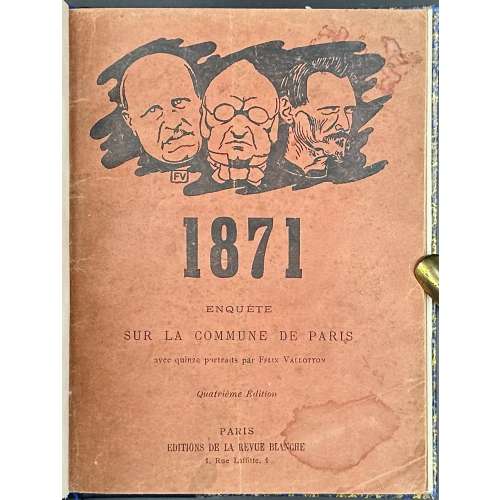 Hardcover, 20.2 x 15.5 cm, owner’s half blue morocco binding over marbled boards with gilt lettering to spine, marbled endpapers, extracts from La Revue Blanche, numbers 91 and 92 of March 15 and April 1 of 1897 (année VII, tome XII), publisher’s pink wrappers preserved, pp. [2] [1-5] 6-160. Ref.: Bridget Alsdorf. Vallotton, Fénéon, and the Legacy of the Commune in Fin-de-siècle France. Portraits: François [Quico] Merlin Colonel Merlin (French, 1814 – 1900) Adolphe Thiers (French, 1797 – 1877) Commandant Gaveau Fortuné Henry (French, 1821 – 1882) Otto von Bismarck (German, 1815 – 1898) Henri, comte de Chambord (French, 1820 – 1883) Louis Rossel (French, 1844 – 1871) François Huet Tranquille (French, 1842 – after 1879) Joseph Vinoy (French, 1803 – 1880) Raoul Rigault (French, 1846 – 1871) Eugène Varlin (French, 1839 – 1871) Théophile Ferré (French, 1845 – 1871) Georges Darboy (French, 1813 – 1871) Auguste Vermorel (French, 1841 – 1871) Jaroslaw Dombrowski [Jarosław Dąbrowski] (Polish-French, 1836 – 1871) Contributors: Félix Fénéon (French, 1861 – 1944) Félix Vallotton (French, 1865 – 1925) La Revue Blanche (Paris) Imprimerie Alcan-Lévy
Hardcover, 20.2 x 15.5 cm, owner’s half blue morocco binding over marbled boards with gilt lettering to spine, marbled endpapers, extracts from La Revue Blanche, numbers 91 and 92 of March 15 and April 1 of 1897 (année VII, tome XII), publisher’s pink wrappers preserved, pp. [2] [1-5] 6-160. Ref.: Bridget Alsdorf. Vallotton, Fénéon, and the Legacy of the Commune in Fin-de-siècle France. Portraits: François [Quico] Merlin Colonel Merlin (French, 1814 – 1900) Adolphe Thiers (French, 1797 – 1877) Commandant Gaveau Fortuné Henry (French, 1821 – 1882) Otto von Bismarck (German, 1815 – 1898) Henri, comte de Chambord (French, 1820 – 1883) Louis Rossel (French, 1844 – 1871) François Huet Tranquille (French, 1842 – after 1879) Joseph Vinoy (French, 1803 – 1880) Raoul Rigault (French, 1846 – 1871) Eugène Varlin (French, 1839 – 1871) Théophile Ferré (French, 1845 – 1871) Georges Darboy (French, 1813 – 1871) Auguste Vermorel (French, 1841 – 1871) Jaroslaw Dombrowski [Jarosław Dąbrowski] (Polish-French, 1836 – 1871) Contributors: Félix Fénéon (French, 1861 – 1944) Félix Vallotton (French, 1865 – 1925) La Revue Blanche (Paris) Imprimerie Alcan-Lévy -
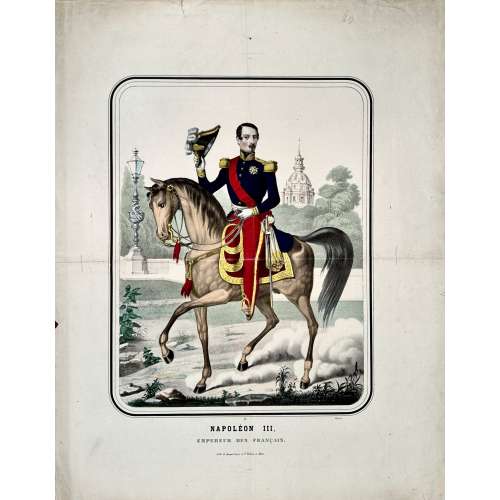 Hand-coloured chromolithography on wove paper, 600 x 470 mm; black ink stamp “4921” to reverse, horizontal and vertical centrefolds. Image of Napoléon III on horseback, in a frame; lettering under the frame: 34 — Déposé | NAPOLÉON III | EMPEREUR DES FRANÇAIS. | Lith. de Gangel frères et P. Didion, à Metz. || Gangel frères et P. Didion (Metz) – printer/publisher. Paulin Didion (French, 1831 – 1879)
Hand-coloured chromolithography on wove paper, 600 x 470 mm; black ink stamp “4921” to reverse, horizontal and vertical centrefolds. Image of Napoléon III on horseback, in a frame; lettering under the frame: 34 — Déposé | NAPOLÉON III | EMPEREUR DES FRANÇAIS. | Lith. de Gangel frères et P. Didion, à Metz. || Gangel frères et P. Didion (Metz) – printer/publisher. Paulin Didion (French, 1831 – 1879) -
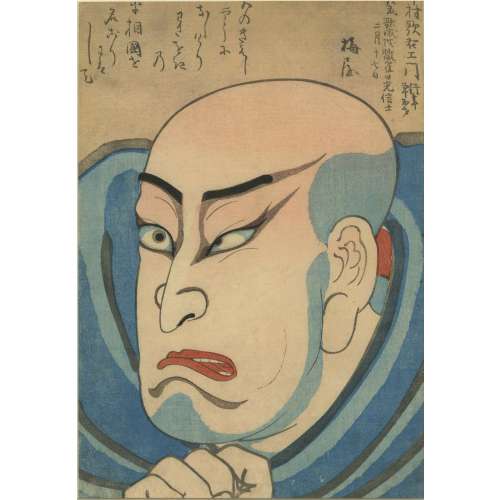 Utagawa Kuniyoshi (attributed to). Memorial portrait (Shini-e, death picture) of Nakamura Utaemon IV (a.k.a. Shikan II) as Taira no Kiyomori (1118-81). Date: 1852. Reference: [LIB-1030.2016] Robert Schaap. Heroes & ghosts: Japanese prints by Kuniyoshi, 1797-1861. — Leiden: Hotei Publishing, 1998; p. 165, image 176. [LIB-3316.2024] Chris Uhlenbeck, Jim Dwinger, Josephine Smit. The Riddles of Ukiyo-e: Women and Men in Japanese Prints. — Brussels: Ludion, 2023; pp. 242-3, № 119. Provenance: Herbert Egenolf Collection, Germany. Literature: Suzuki (1992) 317. Trimmed, unsigned.
Utagawa Kuniyoshi (attributed to). Memorial portrait (Shini-e, death picture) of Nakamura Utaemon IV (a.k.a. Shikan II) as Taira no Kiyomori (1118-81). Date: 1852. Reference: [LIB-1030.2016] Robert Schaap. Heroes & ghosts: Japanese prints by Kuniyoshi, 1797-1861. — Leiden: Hotei Publishing, 1998; p. 165, image 176. [LIB-3316.2024] Chris Uhlenbeck, Jim Dwinger, Josephine Smit. The Riddles of Ukiyo-e: Women and Men in Japanese Prints. — Brussels: Ludion, 2023; pp. 242-3, № 119. Provenance: Herbert Egenolf Collection, Germany. Literature: Suzuki (1992) 317. Trimmed, unsigned. -
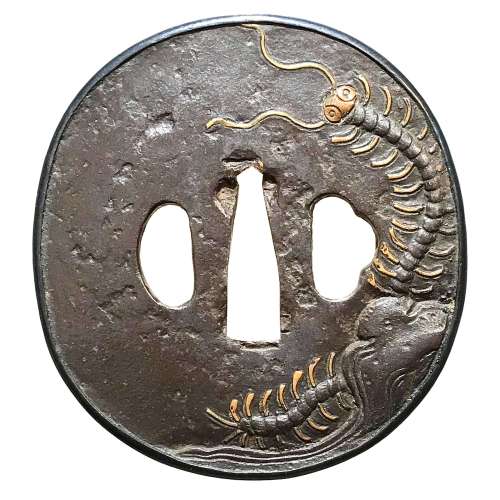
Iron tsuba of oval form with a shakudō fukurin and rough surface decorated by low relief carving and brass inlay with a centipede emerging from under the rock on both sides.
Edo period.Size: 78.9 x 73.6 x 3.8 mm
Unsigned. However, this tsuba may be (though with reservation) attributed to Misumi Kōji school. There is some information regarding this master(s) in Tsuba. An aesthetic study by Kazutaro Torigoye and Robert E. Haynes (from the Tsuba Geijutsu-kō of Kazataro Torigoye. Edited and published by Alan L. Harvie for the Nothern California Japanese Sword Club, 1994-1997) on pages 163-4, though I was not able to locate the tsuba in the original publication. Possibly, this fragment of the book was added by Robert Haynes. Markus Sesko speculates about Misumi in his The Japanese toso-kinko Schools.// Lulu Inc., 2012 on pages 374-5: "Misumi Kōjo Tsuba. Iron plate, elliptical shape, shakudō takabori suemon, yamagane fukurin. Centipede." But of course, visual similarity does not prove anything. I was not able to find any traces of signature or a triangle on the seppa-dai.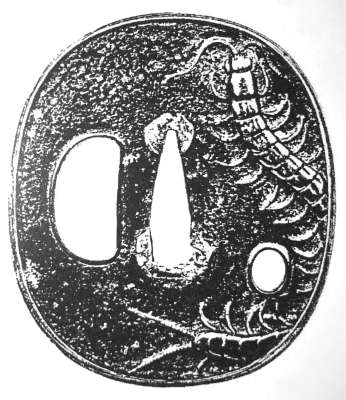
Misumi Kōji Tsuba on p. 163.
-
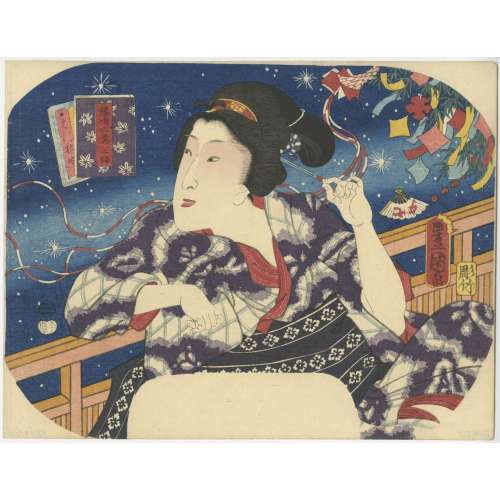 Artist: Utagawa Kunisada [歌川 国貞], a.k.a. Utagawa Toyokuni III [三代 歌川 豊国] (Japanese, 1786 – 1865). Signed: Toyokuni ga [豊国 画] in a red toshidama cartouche Block carver: Yokokawa Takejirō [横川竹二郎] (Japanese, fl. 1845 – 1863), seal: 彫竹 – Hori Take. Publisher: Ibaya Senzaburō [伊場屋仙三郎] (Japanese, fl. c. 1845 – 1847). Combined date and kiwame seal: Ansei 5 (II-XII/1858). Size: Untrimmed fan print (uchiwa-e), 300 x 232 mm.
Artist: Utagawa Kunisada [歌川 国貞], a.k.a. Utagawa Toyokuni III [三代 歌川 豊国] (Japanese, 1786 – 1865). Signed: Toyokuni ga [豊国 画] in a red toshidama cartouche Block carver: Yokokawa Takejirō [横川竹二郎] (Japanese, fl. 1845 – 1863), seal: 彫竹 – Hori Take. Publisher: Ibaya Senzaburō [伊場屋仙三郎] (Japanese, fl. c. 1845 – 1847). Combined date and kiwame seal: Ansei 5 (II-XII/1858). Size: Untrimmed fan print (uchiwa-e), 300 x 232 mm.A young woman adjusting her hairpin on a balcony during the Tanabata festival, as inscribed on the white folding fan: [七夕] (Tanabata).
Inscription on the blue book (print title): Early autumn [はつ秋や] (hatsu akiya), inscription on the purple book (series title): Short love songs, second volume [端唄の意 二編] (Hauta no kokoro nihen). According to Marks (2010), Hauta no kokoro nihen series of fan prints was published by Ibaya in 1858 (p. 267|P6871).
The series refers to love songs of a certain type popular in late Edo. They were performed with the accompaniment of a shamisen, “Seven herbs of autumn, the song of the insects is not heard; the bodies of lightning bugs are burnt, and the precious writings of love are getting thinner like the song of the insects as I am waiting for you. So, on an early autumn evening, I spot the glitter of a lightning bug that lingered among the autumn grasses, and while listening to the pine cricket, I am singing with my heart troubled by love". [Tokyo National Museum; translation provided by Elena Varshavsky].Tanabata [たなばた] or [七夕] – meaning "Evening of the seventh", also known as the Star Festival [星祭] (Hoshi matsuri) – is a Japanese festival originating from the Chinese Qixi Festival. One popular Tanabata custom is to write one's wishes on a piece of paper and hang that piece of paper on a specially erected bamboo tree, in the hope that the wishes become true.
-
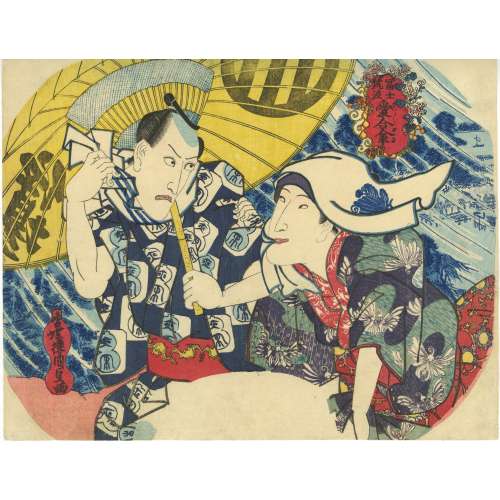 Artist: Utagawa Kunisada [歌川 国貞] a.k.a. Utagawa Toyokuni III [三代 歌川 豊国] (Japanese, 1786 – 1865). An untrimmed fan print titled Fuji Tsukuba aiaigasa, shows the actors Ichikawa Ebizo V [市川海老蔵] and the onnagata actor Iwai Shijaku I [岩井紫若] sharing an umbrella against the wind. Tsukuba, about 50 kilometres from Edo, was an area where both Fuji and Mount Tsukuba could be viewed together. Mount Fuji being the female and Mount Tsukuba the male. An aizuri-e background (common to all the designs in this set). A play on images and words. Actors: Ichikawa Danjūrō VII [市川団十郎] (Japanese, 1791 – 1859); other names: Ichikawa Ebizō V [市川海老蔵], Ichikawa Hakuen II, Ichikawa Shinnosuke I. Iwai Matsunosuke I [岩井松之助] (Japanese, 1804 – 1845); other names: Iwai Hanshirō VII, Iwai Shijaku I [岩井紫若], Iwai Komurasaki I. Publisher: Ibaya Senzaburo [伊場屋仙三郎] (Japanese, fl. c. 1845 – 1847). The publisher’s seal is on the umbrella. Date: circa 1832. Signed: Kōchōrō Kunisada ga in a red double-gourd cartouche. From the series of fan prints:
Artist: Utagawa Kunisada [歌川 国貞] a.k.a. Utagawa Toyokuni III [三代 歌川 豊国] (Japanese, 1786 – 1865). An untrimmed fan print titled Fuji Tsukuba aiaigasa, shows the actors Ichikawa Ebizo V [市川海老蔵] and the onnagata actor Iwai Shijaku I [岩井紫若] sharing an umbrella against the wind. Tsukuba, about 50 kilometres from Edo, was an area where both Fuji and Mount Tsukuba could be viewed together. Mount Fuji being the female and Mount Tsukuba the male. An aizuri-e background (common to all the designs in this set). A play on images and words. Actors: Ichikawa Danjūrō VII [市川団十郎] (Japanese, 1791 – 1859); other names: Ichikawa Ebizō V [市川海老蔵], Ichikawa Hakuen II, Ichikawa Shinnosuke I. Iwai Matsunosuke I [岩井松之助] (Japanese, 1804 – 1845); other names: Iwai Hanshirō VII, Iwai Shijaku I [岩井紫若], Iwai Komurasaki I. Publisher: Ibaya Senzaburo [伊場屋仙三郎] (Japanese, fl. c. 1845 – 1847). The publisher’s seal is on the umbrella. Date: circa 1832. Signed: Kōchōrō Kunisada ga in a red double-gourd cartouche. From the series of fan prints:
Two more prints from the series 'Fuji and Tsukuba sharing an umbrella' (Fuji Tsukuba aiaigasa), not in this Collection: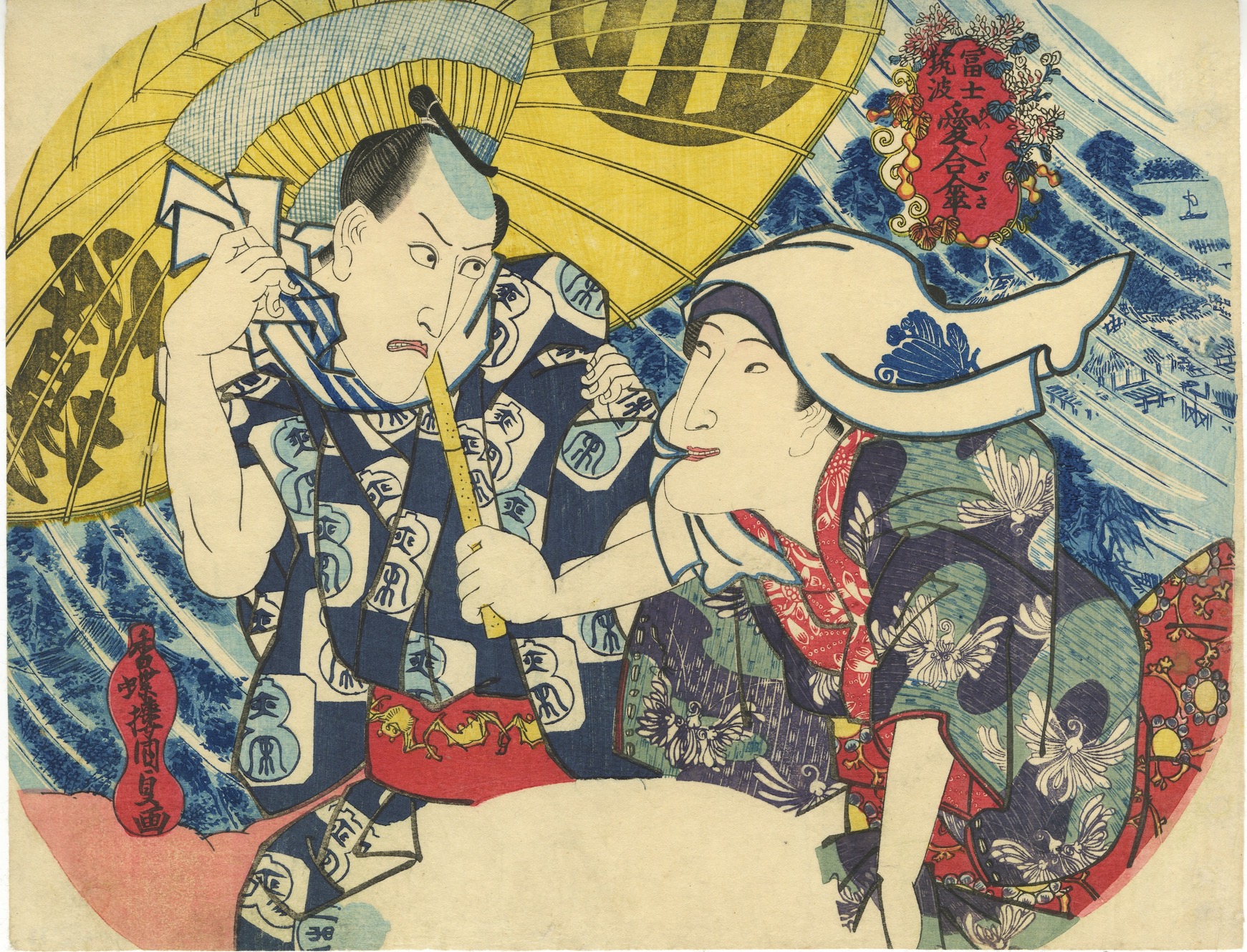
SVJP-0341.2021
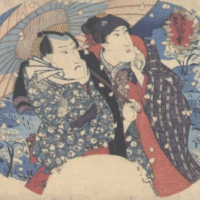
Kabuki actors Onoe Kikugorō III and Iwai Kumesaburo II. Year: c. 1832; Publisher: No seal; Signed: Kōchōrō Kunisada ga From Kunisada Project. 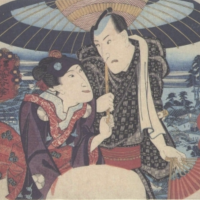
Kabuki actors Bandō Minosuke II and Iwai Shijaku I. Year: c. 1832; Publisher: No seal; Signed: Kōchōrō Kunisada ga From Kunisada Project. -
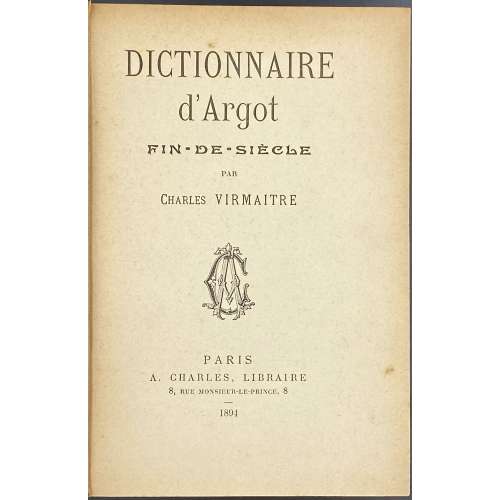 DICTIONNAIRE | d'Argot | FIN-DE-SIÈCLE | PAR | Charles VIRMAITRE | {publisher's device "A.C."} | PARIS | A. CHARLES, LIBRAIRE | 8, RUE MONSIEUR-LE-PRINCE, 8 | 1894 || Pagination : [i-ix] x-xxiii [xxiv blank] [1] 2-336 + [3] 6-176; note: in Supplement – before page 6 only 3 pages. Collation: π4 ii8 [1]-1718 196 (180 leaves) + [1]17 3-[7]18 916 (87 leaves). Binding: Brown cloth, blind double-fillets, gilt lettering to the title.
DICTIONNAIRE | d'Argot | FIN-DE-SIÈCLE | PAR | Charles VIRMAITRE | {publisher's device "A.C."} | PARIS | A. CHARLES, LIBRAIRE | 8, RUE MONSIEUR-LE-PRINCE, 8 | 1894 || Pagination : [i-ix] x-xxiii [xxiv blank] [1] 2-336 + [3] 6-176; note: in Supplement – before page 6 only 3 pages. Collation: π4 ii8 [1]-1718 196 (180 leaves) + [1]17 3-[7]18 916 (87 leaves). Binding: Brown cloth, blind double-fillets, gilt lettering to the title. -
![[Maurice Joly]. Dialogue aux Enfers entre Machiavel et Montesquieu ou la politique de Machiavel au XIX eme Siecle, par Un Contemporain.Publisher: Bruxelles, Imprimerie de A. Mertens et Fils, 1864.](https://varshavskycollection.com/wp-content/uploads/2021/02/LIB-1034-d-scaled-500x500.jpg) Title page: DIALOGUE AUX ENFERS | ENTRE | MACHIAVEL | ET MONTESQUIEU | OU LA POLITIQUE DE MACHIAVEL | AU XIXe SIÈCLE, | PAR UN CONTEMPORAIN. | {6 lines of citations} | ~ | BRUXELLES, | IMPRIMERIE DE A. MERTENS ET FILS, | RUE DE L’ESCALIER, 22. | 1864 ||
Title page: DIALOGUE AUX ENFERS | ENTRE | MACHIAVEL | ET MONTESQUIEU | OU LA POLITIQUE DE MACHIAVEL | AU XIXe SIÈCLE, | PAR UN CONTEMPORAIN. | {6 lines of citations} | ~ | BRUXELLES, | IMPRIMERIE DE A. MERTENS ET FILS, | RUE DE L’ESCALIER, 22. | 1864 ||Description: 18.5 x 12 cm, quarter red morocco over marbled boards, spine with raised bands ruled blind, gilt lettering, marbled endpapers.
Collation: 12mo; fep, 3 blanks, π4 1-2712, 292, 3 blanks, fep.; total 180 leaves. Pagination: [6] [2 h.t] [2 t.p.] [i] ii-iii [iv] [1] 2-337 [338] [2 errata] [6]. Bookplate to front pastedown: “Le Mis de Biencourt” (probably Mademoiselle Anna Charles de Biencourt). See other copies: LIB-2913.2021 and LIB-0460.2015. Other related objects: SVVP-0062.2021. The publication was funded by the author and smuggled into France. Contributors: Maurice Joly (French, 1829 – 1878) -
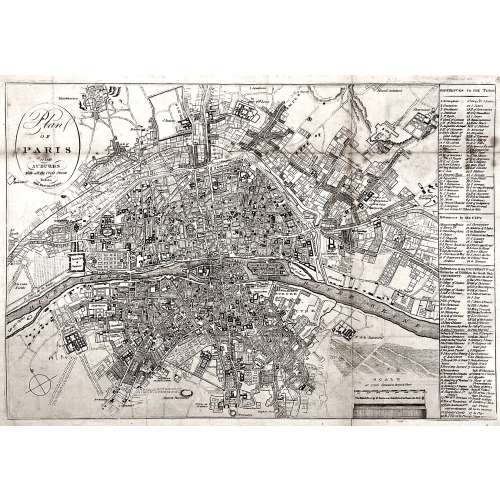 Oval cartouche in the upper-left corner, with tall “s”: Plan | OF | PARIS | and | SUBURBS | With all the Cross Streets | Before | THE REVOLUTION. || No indication of the makers. Dimensions: Sheet: 32.5 x 44.3 cm; Image: 28.5 x 41.3 cm.
Oval cartouche in the upper-left corner, with tall “s”: Plan | OF | PARIS | and | SUBURBS | With all the Cross Streets | Before | THE REVOLUTION. || No indication of the makers. Dimensions: Sheet: 32.5 x 44.3 cm; Image: 28.5 x 41.3 cm. -
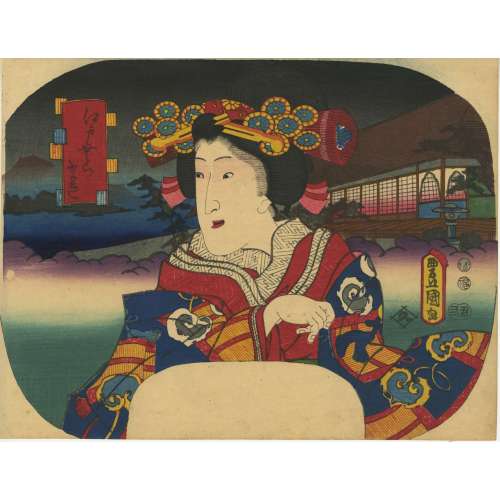 Utagawa Kunisada [歌川 国貞]; a.k.a. Utagawa Toyokuni III [三代歌川豊国] (Japanese, 1786 – 1865). Signed: Toyokuni ga [豊国 画] in a yellow toshidama cartouche. Publisher: Unknown, seal [久] Kyū (Japanese, fl. c. 1851 – 1861); (Marks 07-023 | U176a, possibly Sagamia Kyūzō). Date seal and double nanushi censor seals: Fuku & Muramatsu, Kaei 6, 2nd month (2/1853). Inscription in a red cartouche: Purple of Edo // Purple of the Bay Capital [江都むらさき] (Edo Murasaki), alluding to Murasaki Shikibu [紫 式部] (Japanese, c. 973/8 – c. 1014/31), the author of Genji Monogatari [源氏物語] (The Tale of Genji), a Heian period novel which was the source of a parody Nise Murasaki Inaka Genji [偐紫田舎源氏] (Fake Murasaki’s Rustic Genji) by Ryutei Tanehiko [柳亭種彦] (Japanese, 1783 – 1842). According to Horst Graebner: The actor is most probably Iwai Kumesaburō III. Iwai Hanshirō VIII [岩井半四郎] (Japanese, 1829 – 1882); other names: Iwai Shijaku II, Iwai Kumesaburō III [岩井粂三郎], Iwai Hisajirō II. One of the series of Kunisada's fan prints in this collection:
Utagawa Kunisada [歌川 国貞]; a.k.a. Utagawa Toyokuni III [三代歌川豊国] (Japanese, 1786 – 1865). Signed: Toyokuni ga [豊国 画] in a yellow toshidama cartouche. Publisher: Unknown, seal [久] Kyū (Japanese, fl. c. 1851 – 1861); (Marks 07-023 | U176a, possibly Sagamia Kyūzō). Date seal and double nanushi censor seals: Fuku & Muramatsu, Kaei 6, 2nd month (2/1853). Inscription in a red cartouche: Purple of Edo // Purple of the Bay Capital [江都むらさき] (Edo Murasaki), alluding to Murasaki Shikibu [紫 式部] (Japanese, c. 973/8 – c. 1014/31), the author of Genji Monogatari [源氏物語] (The Tale of Genji), a Heian period novel which was the source of a parody Nise Murasaki Inaka Genji [偐紫田舎源氏] (Fake Murasaki’s Rustic Genji) by Ryutei Tanehiko [柳亭種彦] (Japanese, 1783 – 1842). According to Horst Graebner: The actor is most probably Iwai Kumesaburō III. Iwai Hanshirō VIII [岩井半四郎] (Japanese, 1829 – 1882); other names: Iwai Shijaku II, Iwai Kumesaburō III [岩井粂三郎], Iwai Hisajirō II. One of the series of Kunisada's fan prints in this collection: -
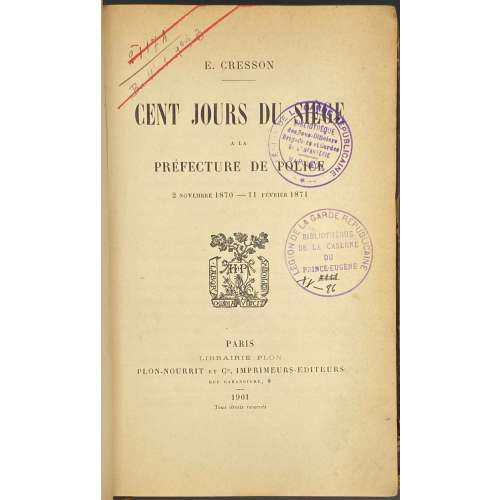 Title-page: E. CRESSON |—| CENT JOURS DE SIÈGE | A LA | PRÉFECTURE DE POLICE | 2 NOVEMBRE 1870 — 11 FÉVRIER 1871 | {publisher’s device} | PARIS | LIBRAIRIE PLON | PLON-NOURRIT ET Cie, IMPRIMEURS-ÉDITEURS | RUE GARANCIÈRE, 8 | 1901 | Tous droits réservés || Description: 8vo, 22 x 14.5 cm, quarter brown calf over marbled boards, flat spine with gilt fillets, gilt lettering, marbled endpapers; inscriptions to t.p.: 2117 A | Ba V –1 1bis 3; ink stamps to t.p.: (1) « LÉGION DE LA GARDE REPUBLICAINE | BIBLIOTÈQUE | des Sous-Officiers | Brigadiers et Gardes | DE L’INFANTERIA | NAPOLEON » ; (2) « LÉGION DE LA GARDE REPUBLICAINE | BIBLIOTÈQUE | DE LA CASERNE | DU | PRINCE-EUGÈNE | (hand) XIII | XX—86 » Collation: 8vo; π6 1-248 252, total 200 leaves. Pagination: [2] [i-v] vi-x, [1] 2-385 [3], total 400 pages. BNF: ark:/12148/bpt6k4936n Author: Ernest Cresson (French, 1824 – 1902)
Title-page: E. CRESSON |—| CENT JOURS DE SIÈGE | A LA | PRÉFECTURE DE POLICE | 2 NOVEMBRE 1870 — 11 FÉVRIER 1871 | {publisher’s device} | PARIS | LIBRAIRIE PLON | PLON-NOURRIT ET Cie, IMPRIMEURS-ÉDITEURS | RUE GARANCIÈRE, 8 | 1901 | Tous droits réservés || Description: 8vo, 22 x 14.5 cm, quarter brown calf over marbled boards, flat spine with gilt fillets, gilt lettering, marbled endpapers; inscriptions to t.p.: 2117 A | Ba V –1 1bis 3; ink stamps to t.p.: (1) « LÉGION DE LA GARDE REPUBLICAINE | BIBLIOTÈQUE | des Sous-Officiers | Brigadiers et Gardes | DE L’INFANTERIA | NAPOLEON » ; (2) « LÉGION DE LA GARDE REPUBLICAINE | BIBLIOTÈQUE | DE LA CASERNE | DU | PRINCE-EUGÈNE | (hand) XIII | XX—86 » Collation: 8vo; π6 1-248 252, total 200 leaves. Pagination: [2] [i-v] vi-x, [1] 2-385 [3], total 400 pages. BNF: ark:/12148/bpt6k4936n Author: Ernest Cresson (French, 1824 – 1902) -
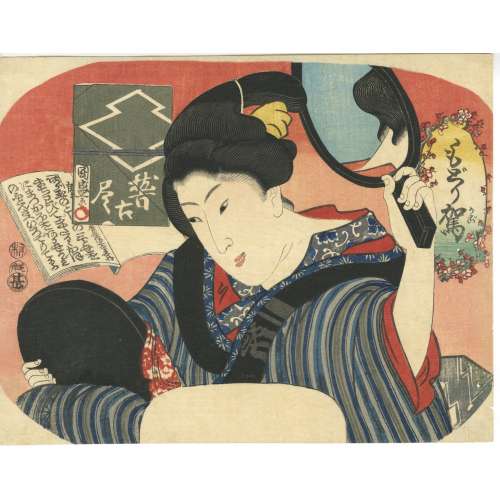 Title: Modori Kago [戻駕] (Returning palanquin). The dance-drama Modori Kago Iro ni Aikata [戻駕色相肩] premiered in the 11th lunar month of 1788 at the Nakamuraza [中村座], within Sakurada Jisuke I's kaomise [顔見世] (faceshowing) program Tôzumô Hana no Edogata [唐相撲花江戸方]", which celebrated the homecoming to Edo, after two years' absence, of Nakamura Nakazō I, and was intended to show off his particular talents in the role of Jirosaku (in reality Ishikawa Goemon [石川 五右衛門]) [kabuki21]. The symbol on a green book cover is the informal crest of tokiwazu-bushi [常磐津節] shaped like a water chestnut (Eleocharis dulcis) lozenge. Artist signature 国盛画 (Kunimori ga) with red toshidama. According to Samuel L. Leiter’s Kabuki Encyclopedia (1979), p. 243: The palanquin bearers Nanpa no Jirosaku and Azuma no Yōshirō, who are bearing a palanquin with a courtesan's young handmaiden in it, stop to rest at Kyoto's Murasakino, and each dances his regional dance. Then they call the girl, who does a dance showing the visitors to the famous pleasure quarters, Yoshiwara and Shimabara. The two men recognize each other as Ishikawa Goemon and Masashiba Hisayoshi, sworn enemies, and engage in a fight. This number is the only remaining section of an annual "faceshowing” (kaomize) work with a plot based on the medieval chronicle called the Toikōki. The full-length piece was called Kara Sumō Hanaeda no Kata. It is one of the most famous tokiwazu pieces and preserves the old-style Kabuki flavour. Nakamura Nakazō I played Jirosaku and Matsumoto Kōshirō IV was Yoshiro in the first production. The handmaiden was Matsumoto Komesaburō (probably Matsumoto Komasaburō I, an unknown actor [SV]). According to Egenolf Gallery: This work was first performed in 1788 at the Edo Nakamura-za as the season’s first performance and featured Nakamura Nakazō, who returned to Edo after three years in Osaka. It was a dance with tokiwazu chanting and was designed for him to play the lead role. In the piece, two palanquin carriers, one from Osaka, another from Edo, and a passenger – a kamuro, (a young geisha-in-training) exchange stories about the pleasure quarters of Shimabara and Yoshiwara. The text of the chanting book is open next to her, carrying the title “Collection of Practicing” [稽古尽くし], on which the green bundle cover carries the crest of Tokiwazu School, matsu-kawa-bishi, diamond variety of pine bark and the artist’s signature. Tokiwazu is a type of jōruri, narrative music, and accompanies dancing on the kabuki stage. Ref.: Christie's 27 Mar 2006. Publisher: Maruya Jinpachi, seal Marujin (Marks: 12-029 | 294e) Single nanushi censor seal: Mura (Murata Sahei, 1842-46). Provenance: Circular seal of the collector Huguette Bérès to verso. Contributors: Utagawa Kunimori [歌川国盛] (Japanese, fl. c. 1818 – 1943) – artist. Maruya Jinpachi [丸屋甚八] (Japanese, fl. 1770 – 1842) – publisher. Other mentioned: Nakamura Nakazō I [中村仲蔵] (Japanese, 1736 – 1790); other names: Nakayama Kojūrō VI, Nakamura Ichijūrō, Nakayama Manzō – actor. Matsumoto Kōshirō IV [松本幸四郎] (Japanese, 1737 – 1802); other names: Omegawa Kyōjūrō; Ichikawa Komazō II, Ichikawa Somegorô I, Ichikawa Takejūrō ; Segawa Kinji; Segawa Kingo – actor. Sakurada Jisuke I [桜田治助] (Japanese, 1734 – 1806) – dramatist.
Title: Modori Kago [戻駕] (Returning palanquin). The dance-drama Modori Kago Iro ni Aikata [戻駕色相肩] premiered in the 11th lunar month of 1788 at the Nakamuraza [中村座], within Sakurada Jisuke I's kaomise [顔見世] (faceshowing) program Tôzumô Hana no Edogata [唐相撲花江戸方]", which celebrated the homecoming to Edo, after two years' absence, of Nakamura Nakazō I, and was intended to show off his particular talents in the role of Jirosaku (in reality Ishikawa Goemon [石川 五右衛門]) [kabuki21]. The symbol on a green book cover is the informal crest of tokiwazu-bushi [常磐津節] shaped like a water chestnut (Eleocharis dulcis) lozenge. Artist signature 国盛画 (Kunimori ga) with red toshidama. According to Samuel L. Leiter’s Kabuki Encyclopedia (1979), p. 243: The palanquin bearers Nanpa no Jirosaku and Azuma no Yōshirō, who are bearing a palanquin with a courtesan's young handmaiden in it, stop to rest at Kyoto's Murasakino, and each dances his regional dance. Then they call the girl, who does a dance showing the visitors to the famous pleasure quarters, Yoshiwara and Shimabara. The two men recognize each other as Ishikawa Goemon and Masashiba Hisayoshi, sworn enemies, and engage in a fight. This number is the only remaining section of an annual "faceshowing” (kaomize) work with a plot based on the medieval chronicle called the Toikōki. The full-length piece was called Kara Sumō Hanaeda no Kata. It is one of the most famous tokiwazu pieces and preserves the old-style Kabuki flavour. Nakamura Nakazō I played Jirosaku and Matsumoto Kōshirō IV was Yoshiro in the first production. The handmaiden was Matsumoto Komesaburō (probably Matsumoto Komasaburō I, an unknown actor [SV]). According to Egenolf Gallery: This work was first performed in 1788 at the Edo Nakamura-za as the season’s first performance and featured Nakamura Nakazō, who returned to Edo after three years in Osaka. It was a dance with tokiwazu chanting and was designed for him to play the lead role. In the piece, two palanquin carriers, one from Osaka, another from Edo, and a passenger – a kamuro, (a young geisha-in-training) exchange stories about the pleasure quarters of Shimabara and Yoshiwara. The text of the chanting book is open next to her, carrying the title “Collection of Practicing” [稽古尽くし], on which the green bundle cover carries the crest of Tokiwazu School, matsu-kawa-bishi, diamond variety of pine bark and the artist’s signature. Tokiwazu is a type of jōruri, narrative music, and accompanies dancing on the kabuki stage. Ref.: Christie's 27 Mar 2006. Publisher: Maruya Jinpachi, seal Marujin (Marks: 12-029 | 294e) Single nanushi censor seal: Mura (Murata Sahei, 1842-46). Provenance: Circular seal of the collector Huguette Bérès to verso. Contributors: Utagawa Kunimori [歌川国盛] (Japanese, fl. c. 1818 – 1943) – artist. Maruya Jinpachi [丸屋甚八] (Japanese, fl. 1770 – 1842) – publisher. Other mentioned: Nakamura Nakazō I [中村仲蔵] (Japanese, 1736 – 1790); other names: Nakayama Kojūrō VI, Nakamura Ichijūrō, Nakayama Manzō – actor. Matsumoto Kōshirō IV [松本幸四郎] (Japanese, 1737 – 1802); other names: Omegawa Kyōjūrō; Ichikawa Komazō II, Ichikawa Somegorô I, Ichikawa Takejūrō ; Segawa Kinji; Segawa Kingo – actor. Sakurada Jisuke I [桜田治助] (Japanese, 1734 – 1806) – dramatist. -
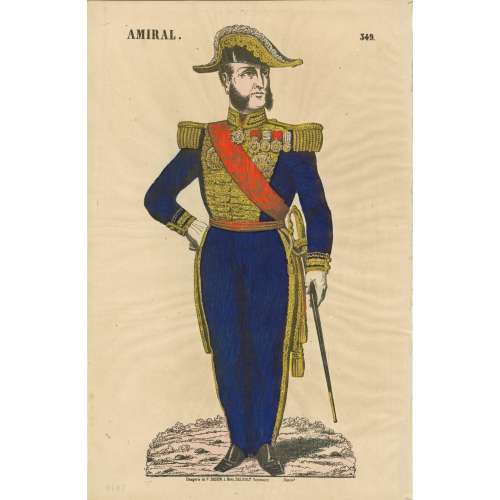 Hand-coloured woodcut on wove paper, 440 x 285 mm; black ink stamp “5049” to reverse. Top left: "AMIRAL"; right: "349". Below: "Imagerie de DIDION, à Metz, DELHALT Successeur." — "Déposé." Paulin Didion (French, 1831 – 1879) – publisher/printer.
Hand-coloured woodcut on wove paper, 440 x 285 mm; black ink stamp “5049” to reverse. Top left: "AMIRAL"; right: "349". Below: "Imagerie de DIDION, à Metz, DELHALT Successeur." — "Déposé." Paulin Didion (French, 1831 – 1879) – publisher/printer. -

Жуковский Ю. Г. Политические и общественные теории XVI-го века. - С.Петербург, 1866. Типография А. Головачева. // Материалы для общественной науки. - 163 с.
Схоластика.
Макиавелли и Томас Мор.
Реформация: Лютер, Кальвин, анабаптисты.
Жан Боден.
[Штамп на титуле: A. Namoradze, Tiflis. 1935.]
-
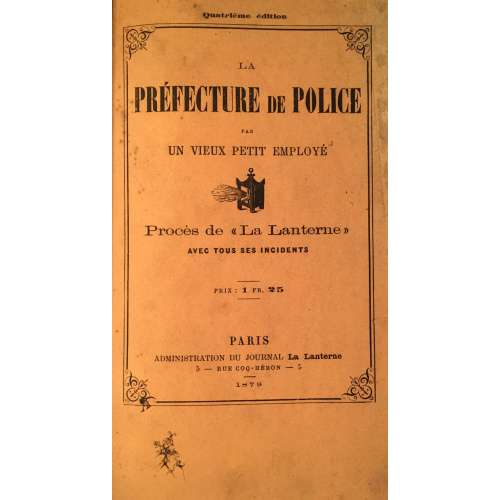
La Préfecture de Police, par un vieux petit employé - Procès de La Lanterne avec tous ses incidents. Administration du journal La Lanterne, Paris, 1879.
Quatrième édition.
Anonymous publication. Authorship attributed to: Yves Guyot, Francisque Sarcey. Source: Harvard College Library, Soc. 3375.6, 14-OCT-1914, Wolcott Fund.



